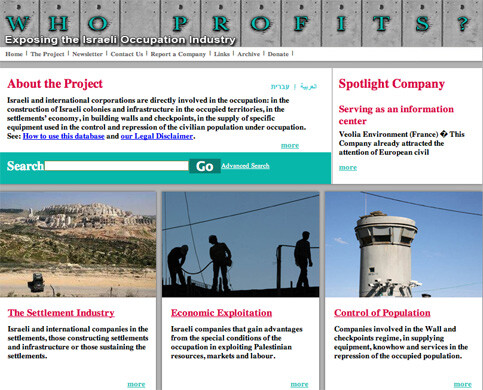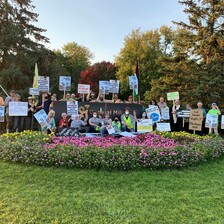The Electronic Intifada 8 February 2009

The front page of whoprofits.org.
Two years ago the Israeli Coalition of Women for Peace set up its project entitled, Who Profits from the Israeli occupation? The coalition has a track record of successfully mobilizing the Israeli public in protests against the occupation, for women’s rights and social-economic justice. For instance, on the day Israel’s onslaught in Gaza began, hundreds of protesters were demonstrating that evening in the streets of Tel Aviv. In January, the Coalition officially launched its on-line database, www.whoprofits.org, listing companies directly involved in the occupation of the West Bank, the Gaza Strip and the Syrian Golan Heights. Dalit Baum, coordinator of the project, explains to The Electronic Intifada contributor Adri Nieuwhof how the project came about.
The Electronic Intifada: Can you please introduce yourself to readers?
Dalit Baum: Let me first of all emphasize that this database is not just the initiative of a small group of lefties, but of a broad coalition. The Coalition of Women for Peace was founded in the early days of the second [Palestinian] intifada, and represents thousands of women organized in nine organizations, including Machsom Watch, Women in Black, Bat Shalom and New Profile. I am one of the co-founders of the coalition. You can find more info about us on our website. The “Whoprofits” project is carried out by a group of activists in our coalition. It is mainly run by volunteers.
I work as an instructor of Women’s Studies at the University of Haifa and at Beit Berl College. For many years I have been involved in direct action to oppose the occupation with Anarchists Against the Wall, Women in Black and Black Laundry.
EI: What motivated the coalition to take up such an ambitious project?
DB: We regularly analyze the role we can play as an Israeli organization in the global movement against the occupation. In the past the debate in Israel focused on the costs of the occupation and about how this money could be used in more constructive ways. The movement used slogans such as “money to the poor neighborhoods instead of to the settlements.” In time, we learned this argument was not convincing to the public. People knew that the occupation is costly, but that there are also economic incentives. It is hard for us in Israel to dissociate ourselves from the economy of the occupation. The occupation gives Israel the benefit of cheap Palestinian land and labor and of a total control over the Palestinian economy to ensure it cannot compete with the Israeli economy.
We decided to shift our perspective and frame the debate in terms of who profits from the occupation. The past two years we have worked on mapping Israeli and international corporations directly involved in the construction of Israeli colonies and infrastructure in the occupied territories, in the settlements’ economy, in building walls and checkpoints, in the supply of specific equipment used in the control and repression of the civilian population under occupation. We have learned that our database contributes to fill the international information gap. Our work complements the work done by global activists campaigning against the corporate involvement in the occupation of companies such as Motorola, Assa Abloy, Unilever, Veolia, and Africa-Israel, because we are on the ground, we can go to settlements and we have access to information in Hebrew.
EI: How do you make sure the database is a reliable source?
DB: All the information about companies published on our website is based on collected hard evidence. We collect documents from the companies involved, and from Israeli government bodies. We also collect evidence by visiting sites and taking pictures of the presence of companies in the occupied territories. For each company we have a file with first hand accounts of its involvement. We have much more info than is published on the website. We found that many factories operating in the Israeli industrial zones in the West Bank are not registered as such. It requires more work to expose their involvement in the occupation. We are thorough in our research, but of course appreciate to receive feedback on how we can improve the quality of the database and any correction and additions sent to us will be checked.
EI: What is your view on the boycott of settlement products?
DB: In many countries activists organize boycott campaigns of specific settlement products. But our database is not a boycott list. We are trying to offer a broader scope including companies profiting from the settlement industry, economic exploitation of Palestinian resources, markets and labor, and the control of the Palestinian population. For us as Israeli activists, it is quite impossible to dissociate ourselves from all these companies. Our mapping includes major Israeli banks, international high-tech companies, and transportation giants, with different levels of involvement.
We believe that civil society can and should try and change these corporate policies, but there should be different methods in approaching these different companies. For instance Veolia as a company involved in the Israeli light rail project in Jerusalem, involved in the practical annexation of settlements to Israel we have managed to help uncover the fact that they also operate a landfill in the occupied Jordan Valley. Another example is HeidelbergCement, owner of Hanson Israel, a company with four plants in the West Bank, including a stone quarry, exploiting nonrenewable Palestinian natural resources in the Israeli construction industry.
We would like to encourage activists to be creative. A letter to Hewlett Packard questioning [the involvement of their subsidiary,] EDS Israel, in the automated biometric access control system installed in major checkpoints is for us as important as the Swedish campaign that led to Assa Abloy’s decision to divest from Barkan Industrial Zone.
EI: What has been the response to the database in Israel?
DB: For two years we have been working mostly under the radar. We managed to work with and assist many groups in Israel and abroad. Now is the time to give more publicity to the database. It serves our goal of educating the Israeli public about how companies profit from the occupation of Palestine. It also offers the public a new mapping of different types of involvement in the occupation, and exposes how this involvement has permeated big parts of the Israeli economy, including big banks, major telecommunication firms, construction and transportation firms. It is not clear yet what the response will be.
EI: What are your criteria for success of the Whoprofits database?
DB: I would consider our database a success when it serves our educational goal. I want us to succeed in reaching out to more people, in Israel and abroad, to inform them about how companies and economic interests sustain the Israeli occupation. Then, I personally would want to see people try and influence the interests of these companies, in order to help stop the occupation. In a few years’ time I hope that companies will be more worried about being seen as involved in the occupation in any way and even appeal to remove their listing on our website. The real success would be in changing public opinion and actually ending the occupation.
Adri Nieuwhof is a consultant and human rights advocate.
Related Links





